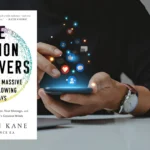Hey there, fellow growth enthusiast! Whether you’re launching the next big app, scaling your startup, or just curious about how companies like Uber and Airbnb skyrocketed to success, The Cold Start Problem by Andrew Chen is a goldmine. Today, I’ll break down this must-read book in a fun, digestible way. Let’s dive in!
Why Read This Book?
Picture this: you have a brilliant idea, but getting people to use it feels like pulling teeth. Sound familiar? That’s the “cold start problem” in action—the chicken-and-egg dilemma every platform or networked product faces in its early days.
Andrew Chen, a former Uber exec and partner at Andreessen Horowitz, takes us on a journey through the art and science of building networks that actually work. Whether you’re a founder, marketer, or just a curious mind, this book arms you with actionable strategies, real-life stories, and eye-opening insights about how network effects fuel growth.
The Cold Start Problem: What’s the Big Deal?
At its core, the cold start problem is about momentum. When a new product or service launches, it needs users to create value—but how do you get users without value already in place? It’s a tricky balancing act, but once you solve it, network effects kick in, and your product can take off.
Chen divides the process into five stages:
- The Cold Start Problem – That tough beginning.
- The Tipping Point – When things start to click.
- Escape Velocity – Growth becomes self-sustaining.
- Hitting Scale – Managing explosive growth.
- The Moat – Building defenses to protect your network.
Each stage comes with its own challenges, strategies, and opportunities.
Building Your Own Network Effects (In-Depth Edition)
Let’s roll up our sleeves and dig deeper into the strategies Andrew Chen shares for cracking the cold start problem and building unstoppable network effects. Whether you’re an entrepreneur, a product manager, or just someone fascinated by how products grow, these takeaways will give you actionable insights to level up your game.
Start Small and Nail the Core Interaction
It’s tempting to dream big and go wide right from the start, but that’s the fastest way to fail. Instead, focus on creating a niche experience that is laser-focused on one core interaction—the action that creates value for your users.
Why This Matters: If you spread yourself too thin, your product won’t serve anyone well. Early adopters want a solution to their specific problem, not a watered-down experience meant for everyone.
Real-Life Example: Take Tinder. They didn’t start as a global dating platform. They launched on college campuses, where social connections were already tight-knit. The swiping interaction was simple, addictive, and perfectly suited for their audience.
How to Apply: Find your “smallest viable market.” Identify a group of people with a shared problem and obsess over creating an experience they can’t live without. Ask yourself: What’s the one thing users should feel compelled to do as soon as they open your app?
Identify Your Atomic Network
The “atomic network” is the smallest group of users that can achieve value on your platform independently. This is the foundation of your network effects. Without it, your product will crumble.
Why This Matters: Users will only stick around if they can derive value without needing the entire world on your platform. The atomic network ensures that even with a small user base, there’s enough activity to make the experience worthwhile.
Real-Life Example: For Airbnb, their atomic network wasn’t global travelers—it was one city. By focusing on building supply (hosts) and demand (guests) in San Francisco, they created a dense local ecosystem where users could reliably find a place to stay.
How to Apply: Break your product down to its core components. Ask: What’s the smallest group that can engage with the platform and see value? It could be one college, one neighborhood, or even one chat group. Focus your early efforts there before thinking about scaling.
Leverage Existing Networks
Building a network from scratch is tough, but you don’t have to reinvent the wheel. Tap into platforms or communities that your target audience already uses.
Why This Matters: By integrating with or riding the wave of existing networks, you can acquire users faster and lower the barrier to entry. Think of it as hitching a ride on someone else’s momentum.
Real-Life Example: Instagram did this brilliantly by launching as an app that improved photos for Facebook and Twitter users. They didn’t try to compete directly with those platforms at first. Instead, they used them as distribution channels, allowing users to share their edited photos directly.
How to Apply: Identify where your target users already hang out. Are they on Reddit? Slack? TikTok? Figure out how to provide value in those spaces, whether through integrations, partnerships, or content. Look for ways to embed your product into their existing habits.
Build an Onboarding Process That Creates Instant Value
The first experience your users have with your product can make or break your network. If they don’t find value quickly, they’ll leave—and convincing them to return will be 10x harder.
Why This Matters: A smooth and rewarding onboarding experience accelerates growth by helping users connect with others or interact with the product right away.
Real-Life Example: When Facebook launched, it didn’t just let users sign up and figure things out on their own. It prompted them to add friends immediately, ensuring that their feed was instantly populated with content.
How to Apply: Analyze your onboarding flow. How quickly can users start engaging with your product? Remove unnecessary friction and focus on delivering a “wow” moment early—whether it’s connecting with a friend, getting their first match, or completing their first task.
Focus on Retention Before Growth
Growth is exciting, but it’s pointless if users churn as fast as they join. Retention is the bedrock of any successful network effect. Without it, your network will eventually collapse.
Why This Matters: Retention is a sign that your product is genuinely solving a problem. If users keep coming back, they’ll also invite others, creating organic growth.
Real-Life Example: Slack’s explosive growth wasn’t just about acquiring users. Teams loved the tool so much that they integrated it into their daily workflows. This high retention rate made it easier for Slack to expand within organizations.
How to Apply: Focus on understanding why your users stay—or leave. Use surveys, interviews, and analytics to identify what keeps them engaged and double down on those features. Remember, you don’t need a massive user base at first; you need a sticky one.
Defend Your Network Once It’s Built
Once you’ve scaled and your network effects are strong, competitors will inevitably try to poach your users or replicate your success. This is where you build your “moat”—your unique, defensible advantages.
Why This Matters: If anyone can copy your product or steal your users, your success won’t last long. A strong moat ensures that your network remains the go-to choice for your users.
Real-Life Example: Amazon’s Prime membership is a classic example of a moat. By offering fast shipping, exclusive deals, and other perks, they created a loyalty program that competitors struggle to match.
How to Apply: Think about what makes your network irreplaceable. Is it the depth of your user base? The quality of your data? The strength of your community? Invest in these areas to create barriers for competitors.
By focusing on these six pillars, you can overcome the cold start problem and build a network that doesn’t just grow—it thrives. Each step is about understanding your users deeply, solving their problems in meaningful ways, and creating a product they can’t stop talking about.
So, what’s your next move? Whether you’re building a platform, launching an app, or just brainstorming your big idea, these takeaways are your blueprint for success. Let’s get to work!
What Makes This Book Different?
Unlike other business books, Chen doesn’t just give you a blueprint and call it a day. He breaks down the psychological and emotional side of building networks—how users behave, why they join, and what keeps them around.
Plus, his writing is refreshingly practical and full of stories you’ll actually want to read. No fluff, just actionable insights.
Real-Life Examples: How the Pros Did It
Chen doesn’t just theorize; he spills the beans on how today’s biggest names solved their cold start problem. Here are a few gems:
- Uber: They didn’t start with a giant network of drivers and riders. Instead, they focused on small, dense areas (like San Francisco) to create a perfect supply-demand loop before expanding.
- Zoom: During the pandemic, they became the video conferencing tool because they nailed usability and reliability. This simplicity made it easy for early adopters to bring others on board.
- LinkedIn: By focusing on professionals and allowing users to build profiles, they made it easy to network in a way that hadn’t been done before.
Join the Conversation!
So, what do you think? Have you faced the cold start problem in your own projects? Or maybe you’ve been part of a network that grew like wildfire? Share your experiences in the comments—I’d love to hear from you!
If you haven’t picked up The Cold Start Problem yet, trust me, it’s worth the read. Whether you’re building the next big thing or just curious about how networks shape our world, this book is a game-changer.
Top 5 Quotes from The Cold Start Problem
“Every product starts empty.”
This quote hits home because it reminds us that even the biggest platforms today—like Facebook, Uber, or Airbnb—started with zero users. It’s a powerful mindset shift: growth isn’t about magic, it’s about building from scratch with intention.
“The most important product decisions are not about features, but about who is in the network.”
Chen emphasizes that great products aren’t just a sum of their parts—they’re defined by the people using them. The right users create the right network effects.
“Find your atomic network. Build it. Then replicate it.”
This is a game-changing strategy. Instead of trying to grow everywhere at once, the key is to build one small, thriving group that delivers value—and then use that as a model to scale.
“Growth is not a marketing function. It’s a product function.”
A killer reminder that true growth comes from building something people want to use and share. No amount of advertising can fix a product that doesn’t work for its users.
“The strongest networks aren’t just built—they’re defended.”
Chen underscores the importance of protecting what you’ve built. Once your product scales, the next challenge is keeping your users engaged and fending off the competition.


